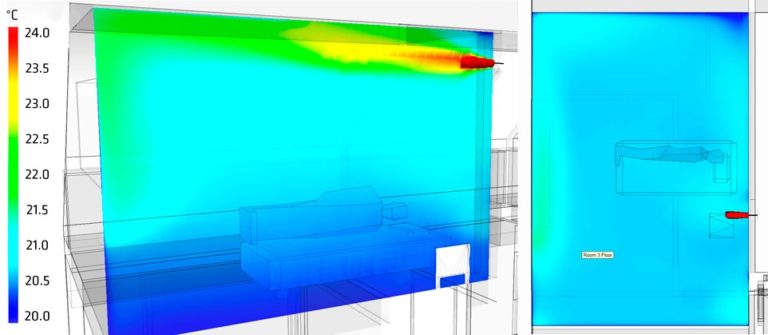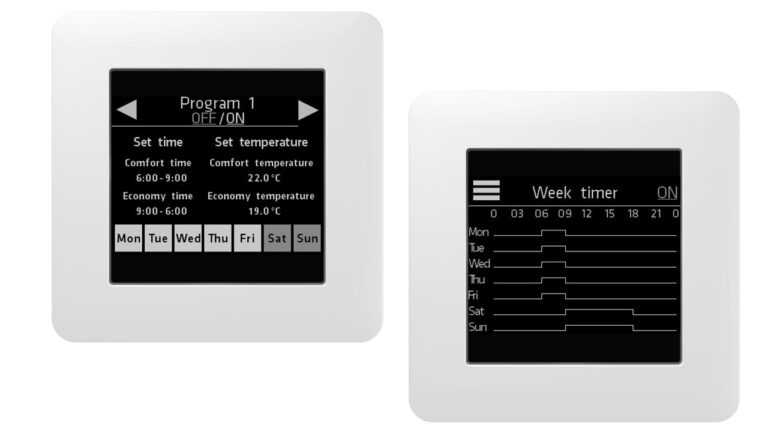ECO forced air heating system for passive houses
The ECO forced air heating series combines elegant design with high-end features. Heating and ventilation have been combined into one reliable and energy-efficient unit.
The optimal solution for passive house heating
The heating energy requirement in passive houses is merely 20–30 kWh per gross square meter, and the total primary energy requirement must be a maximum of 130–140 kWh / m².
For this reason, it is also a good idea to choose energy-efficient heating explicitly designed for passive houses.
- ECO valves are combined with a heating resistor that heats the air in the room. There is no heat loss when warm air does not enter the space through the ductwork.
- Heating can be adjusted on a room-by-room basis.
- Air heating reacts very quickly to temperature changes, and the room temperature can be kept at the desired level even if there is an extra heat load in the space, for example, from the fireplace or the sun.
Up to 20% more energy-efficient heating
The system meets the Eco Design Directive’s criteria and the Ecodesign Act 2018 requirements. According to the directive, the high energy efficiency and low environmental impact of electronic products must be proven by testing.
As a result of simulations carried out with IDA ICE software, the ECO system saves 6-13% in heating energy consumption and 18-20% in HVAC system consumption compared to more conventional heating systems in Southern Finland conditions.
Compared to other heating systems, ECO’s timing and boost possibilities are in a class of their own, and during the heating season, the room temperature remains more stable. In addition to efficient heating start-up, the thermostat takes into account the effects of heating, heat accumulations, and outdoor temperature on the room temperature.
ECO-series products

The smart thermostat keeps room temperature constant
Passive houses are built to be tight and very well-insulated. Heating can be brought into the room from the wall and ceiling without compromising thermal comfort. The reactive and accurate ECO system keeps the room temperature constant, even if the heat loads in the room vary.
In the picture next to it, the ECO system lowers the supply air temperature when a heat load of 500W is brought into the room. However, the room air temperature shown in grey remains at the desired 20 degrees Celsius at all times.
Minimal temperature stratifications and constant temperature
In a passive house, temperature stratifications are minimal; consequently, the vertical temperature distribution is uniform throughout the room.
The simulation images show how the temperature is evenly distributed throughout the room and remains within a couple of degrees in the living zone. Horizontally, at a height of 1.1 meters, the air temperature remains within half a degree in different room parts.


The smart room control adapts to the resident’s rhythm
The versatile and user-friendly ECO-T room controller can save energy in heating. It has versatile functions, heating timing, and a system that learns with use.
- Room temperatures can be easily programmed for each day. The weekly clock enables energy savings during periods when you are away from home or at night by lowering the temperature in rooms where heating is not needed.
- The temperature can be changed, for example, when leaving the house, and can be easily adjusted using the plus and minus buttons on the display.
- The ECO controller works adaptively and learns from its environment. It learns to start heating at just the right time.
- You can set the maximum temperature and PIN code to restrict access to the settings. For example, it may be a good idea to limit the maximum temperature sometimes and prevent changing settings with a PIN for rental apartments and Airbnb-type solutions.
Integration with building automation
- The Modbus can connect the ECO forced air heating system to building automation. In this case, the heating can be controlled through the most common Smart living building automation systems, as well as to see the temperature of each room and its setpoints.
- ECO forced air heaters can also be controlled directly via the Modbus bus without ECO-T controllers. The Modbus bus can also be used in locations where, e.g., the BACnet bus is in use.
Do you have any questions?
Do not hesitate to contact our personnel.
Or fill in the form below and we will be in contact!



